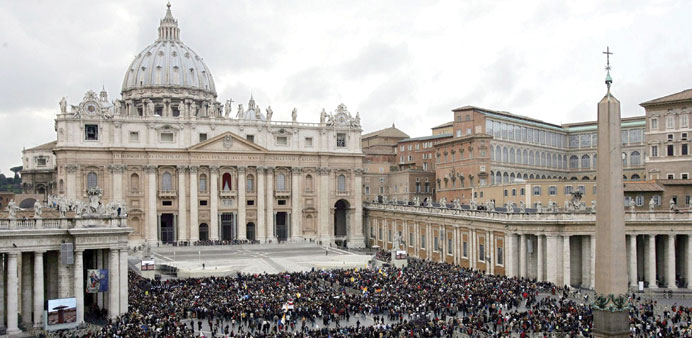By Miriam Schmidt
The Vatican City is the smallest sovereign state in the world and mostly located behind high imposing walls with just a small area, including St Peter’s Basilica, the Sistine Chapel and the treasures of the Vatican Museum open to visitors.
The Sistine Chapel, by far the Vatican’s greatest tourist attraction with its magnificent frescoes by Michelangelo, is currently off limits to the public as the cardinals of the Catholic Church meet to elect Pope Benedict XVI’s successor.
The cardinals sleep in the imposing Domus Sanctae Marthae palazzo in the shadow of St Peter’s Basilica and each morning are escorted from their sleeping quarters and led to the Sistine Chapel.
The best spot for curious onlookers to watch proceedings is from St Peter’s Square, not least because from here they will be able to see when white smoke emerges from the Sistine Chapel chimney, telling the world’s 1.2bn Catholics they have a new pope.
The conclave to elect a new pope has taken place in the Sistine Chapel since 1878. The chapel attracts up to 20,000 visitors a day and is most famous for its frescoed ceiling, painted by Michelangelo between 1508 and 1512.
Michelangelo’s The Last Judgment is widely believed to be the artist’s crowning achievement in painting. There are also over 300 sculpted figures on view as well as works by Sandro Botticelli, Pietro Perugino and Pinturicchio.
Formerly the Cappella Magna, the Sistine Chapel takes its name from Pope Sixtus IV, who restored the building between 1471 and 1481. Although probably best known for being the location of papal conclaves, it is also the Papal Chapel and has six large arched windows on each of its two long walls.
A tapestry designed by Raphael shows scenes from the gospels while there are also frescoes with scenes from the lives of Moses and Jesus as well as 24 large papal portraits.
When the papal conclave is not sitting, entry to the Sistine Chapel is gained via the Vatican Museum, which stretches to over 1,400 rooms and boasts one of the largest art collections in the world. Visitors need to cover a distance of seven kilometres to see all 50,000 objects on display in the 14 museums.
Tourists from across the globe descend on the Vatican Museum every day, wondering at the seemingly never-ending treasure trove of frescoes, paintings, tapestries and archaeological artefacts.
Covering just 44 hectares, the Vatican City is home to the pope and his cardinals. There are only around 550 Holy See passport holders while the state’s resident population is estimated at 900 people.
Apart from the museums, only a small section of the Vatican is open to the public, most importantly St Peter’s Square and Basilica. During the day the square, which was completed in 1667, is crowded with pilgrims and tourists.
At the centre of the square is a 4,000-year-old Egyptian obelisk, erected in 1568, while massive Tuscan colonnades, four columns deep, frame its entrance and 140 over life-size saints crown the cornice.
St Peter’s Basilica is another huge tourist attraction, drawing millions of visitors each year to the world’s largest Christian cathedral.
The cupola is one of Rome’s landmark sights. It is possible to climb the 320 steps to the top of the dome with the entrance at the far right of the portico. If this is too strenuous, visitors can take an elevator as far as the roof terrace, and enjoy the view from the gallery inside the dome looking down into the basilica.
The view of the Vatican Gardens, a private garden complex within the Holy See, is particularly impressive. The gardens, which cover 23 hectares and comprise the majority of the Vatican State, can only be visited on a guided tour by prior appointment.
The lush gardens filled with brilliantly coloured flowers, groves of mature oak trees, and ancient fountains and pools date back to the 13th Century when Pope Nicholas III developed the land within the Vatican walls.
There is also a small summerhouse, Villa Pia, built for Pope Pius IV in 1560 by Pirro Ligorio, as well as medieval fortifications some of which date back to the ninth century.
From the dome, it is also possible to see the new retirement home for Pope Benedict XVI. The Mater Ecclesiae nunnery was once the home of the Vatican’s head gardener before being converted into a retreat for groups of nuns. — DPA

St Peter’s Square in the Vatican.


